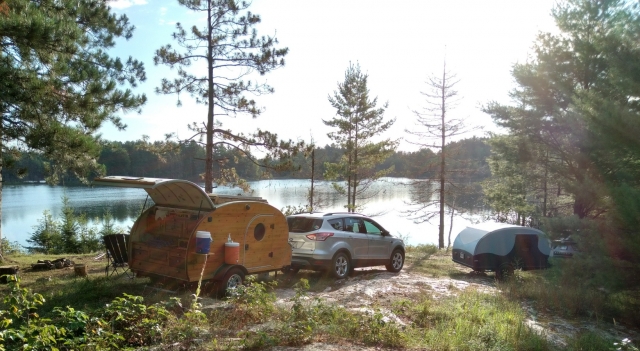
Anyone used "Common Board" for their wood?
17 posts
• Page 1 of 2 • 1, 2
Anyone used "Common Board" for their wood?
Hello knowledgeable people, I was looking at wood for my framing (skeleton) and came across "Common Board". The one I saw was 1 x 2 x 8, its light. I tried to research it online and it came back as softwood/pine. I was thinking of using it for my floor skeleton, since its light I may go 1 x 3 x 8 (which I think I saw as well). I will use foam insulation in the voids. Any thoughts on "common board"? 

- 23Sojourney45
- Teardrop Advisor
- Posts: 90
- Images: 0
- Joined: Wed May 03, 2023 1:44 pm
- Location: California
Re: Anyone used "Common Board" for their wood?
"Common" is a grade designation, such as #1 common or #2 common. #1 should be free of knots and cracks. #2 will have knots and some minor defects. I won't go into all the different nomenclature that the retail industry uses since some dream up marketing terms of their own.
See https://www.highlandhardwoods.com/lumber/lumber-terminology/
I'm assuming you are referring to wall construction. Floor construction is not critical IMO as far as the grade of the skeleton material. In the walls, avoiding large knots in the skeleton may be desirable as you fasten sheet material to the skeleton. It is not necessary, it's just easier to avoid splitting the lumber or having fasteners stand proud of the surface when driving screws, staples or nails. Is it worth the extra cost of "clear" lumber? That's up to you. If you accept that a random fastener may not sink in properly when it hits a knot then go for #2 common. Just be ready to have a method to remove the fastener or pound it in deeper with a hammer and spackle the hole if needed. If you are going for a nice wood finish on the interior or exterior surfaces stay with #1 lumber so you have less chance of a wayward fastener.
I hope that at least partially answers your question.
Some other descriptions I can think of include...
SPF (Spruce/Pine/Fir), these are softwoods.
Whitewood (softwood pine/spruce), often without interesting grain patterns. Occasionally just another name for #2 Common.
Standard, Quality, Select... Standard is probably closest to #2 Common, Quality has a few more "defects" such as knots, Select is closest to #1 Common with little to no defects. Menards uses this grade description on their 1" softwood lumber
See https://www.highlandhardwoods.com/lumber/lumber-terminology/
I'm assuming you are referring to wall construction. Floor construction is not critical IMO as far as the grade of the skeleton material. In the walls, avoiding large knots in the skeleton may be desirable as you fasten sheet material to the skeleton. It is not necessary, it's just easier to avoid splitting the lumber or having fasteners stand proud of the surface when driving screws, staples or nails. Is it worth the extra cost of "clear" lumber? That's up to you. If you accept that a random fastener may not sink in properly when it hits a knot then go for #2 common. Just be ready to have a method to remove the fastener or pound it in deeper with a hammer and spackle the hole if needed. If you are going for a nice wood finish on the interior or exterior surfaces stay with #1 lumber so you have less chance of a wayward fastener.
I hope that at least partially answers your question.
Some other descriptions I can think of include...
SPF (Spruce/Pine/Fir), these are softwoods.
Whitewood (softwood pine/spruce), often without interesting grain patterns. Occasionally just another name for #2 Common.
Standard, Quality, Select... Standard is probably closest to #2 Common, Quality has a few more "defects" such as knots, Select is closest to #1 Common with little to no defects. Menards uses this grade description on their 1" softwood lumber
Tim
Niagara, WI
My First Benroy Teardrop Build Thread - A 5x8 Woodie - http://www.tnttt.com/viewtopic.php?f=50&t=63575
My Second Teardrop (partial) Build Thread - Started August '16 - http://www.tnttt.com/viewtopic.php?f=50&t=66939
#3 My son's Benroy Foamie team build - Started July '20 - http://www.tnttt.com/viewtopic.php?f=50&t=72877

Niagara, WI
My First Benroy Teardrop Build Thread - A 5x8 Woodie - http://www.tnttt.com/viewtopic.php?f=50&t=63575
My Second Teardrop (partial) Build Thread - Started August '16 - http://www.tnttt.com/viewtopic.php?f=50&t=66939
#3 My son's Benroy Foamie team build - Started July '20 - http://www.tnttt.com/viewtopic.php?f=50&t=72877
-

TimC - Gold Donating Member
- Posts: 1439
- Images: 751
- Joined: Sat May 23, 2015 4:15 am
- Location: WI/MI border







